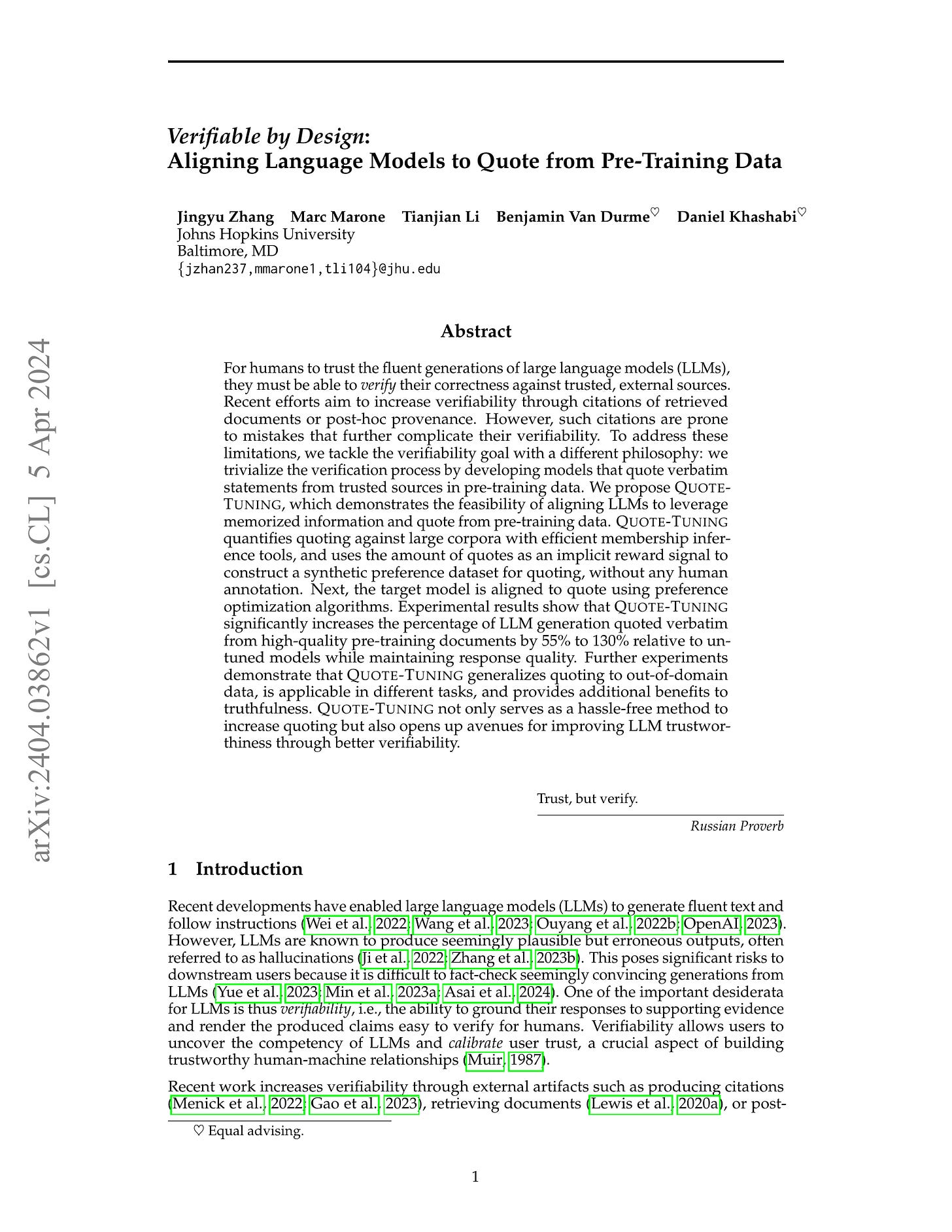2024년 4월 8일
Direct Nash Optimization: Teaching Language Models to Self-Improve with General Preferences
(Corby Rosset, Ching-An Cheng, Arindam Mitra, Michael Santacroce, Ahmed Awadallah, Tengyang Xie)
This paper studies post-training large language models (LLMs) using preference feedback from a powerful oracle to help a model iteratively improve over itself. The typical approach for post-training LLMs involves Reinforcement Learning from Human Feedback (RLHF), which traditionally separates reward learning and subsequent policy optimization. However, such a reward maximization approach is limited by the nature of "point-wise" rewards (such as Bradley-Terry model), which fails to express complex intransitive or cyclic preference relations. While advances on RLHF show reward learning and policy optimization can be merged into a single contrastive objective for stability, they yet still remain tethered to the reward maximization framework. Recently, a new wave of research sidesteps the reward maximization presumptions in favor of directly optimizing over "pair-wise" or general preferences. In this paper, we introduce Direct Nash Optimization (DNO), a provable and scalable algorithm that marries the simplicity and stability of contrastive learning with theoretical generality from optimizing general preferences. Because DNO is a batched on-policy algorithm using a regression-based objective, its implementation is straightforward and efficient. Moreover, DNO enjoys monotonic improvement across iterations that help it improve even over a strong teacher (such as GPT-4). In our experiments, a resulting 7B parameter Orca-2.5 model aligned by DNO achieves the state-of-the-art win-rate against GPT-4-Turbo of 33% on AlpacaEval 2.0 (even after controlling for response length), an absolute gain of 26% (7% to 33%) over the initializing model. It outperforms models with far more parameters, including Mistral Large, Self-Rewarding LM (70B parameters), and older versions of GPT-4.
Nash Learning (https://arxiv.org/abs/2312.00886) 을 단순화한 알고리즘이군요. Online Response를 샘플링한 다음 Preference 함수로 랭킹하고 가장 순위 차이가 많이 나는 페어를 사용해 DPO를 합니다. West-of-N (https://arxiv.org/abs/2401.12086) 을 생각나게 하는 부분이 있네요.
결과적으로 GPT-4로 랭킹을 반복적으로 획득한 다음 GPT-4로 평가하는 패턴이긴 합니다.
#rlhf
No "Zero-Shot" Without Exponential Data: Pretraining Concept Frequency Determines Multimodal Model Performance
(Vishaal Udandarao, Ameya Prabhu, Adhiraj Ghosh, Yash Sharma, Philip H.S. Torr, Adel Bibi, Samuel Albanie, Matthias Bethge)
Web-crawled pretraining datasets underlie the impressive "zero-shot" evaluation performance of multimodal models, such as CLIP for classification/retrieval and Stable-Diffusion for image generation. However, it is unclear how meaningful the notion of "zero-shot" generalization is for such multimodal models, as it is not known to what extent their pretraining datasets encompass the downstream concepts targeted for during "zero-shot" evaluation. In this work, we ask: How is the performance of multimodal models on downstream concepts influenced by the frequency of these concepts in their pretraining datasets? We comprehensively investigate this question across 34 models and five standard pretraining datasets (CC-3M, CC-12M, YFCC-15M, LAION-400M, LAION-Aesthetics), generating over 300GB of data artifacts. We consistently find that, far from exhibiting "zero-shot" generalization, multimodal models require exponentially more data to achieve linear improvements in downstream "zero-shot" performance, following a sample inefficient log-linear scaling trend. This trend persists even when controlling for sample-level similarity between pretraining and downstream datasets, and testing on purely synthetic data distributions. Furthermore, upon benchmarking models on long-tailed data sampled based on our analysis, we demonstrate that multimodal models across the board perform poorly. We contribute this long-tail test set as the "Let it Wag!" benchmark to further research in this direction. Taken together, our study reveals an exponential need for training data which implies that the key to "zero-shot" generalization capabilities under large-scale training paradigms remains to be found.
이미지 텍스트 페어에서 이미지와 텍스트 모두에 같은 "개념"이 나타난 샘플들의 수를 구합니다. 그리고 이 샘플들의 수에 따른 성능 변화를 측정했네요. 여기서 Log Linear한 패턴이 나타났습니다. 즉 성능의 증가를 위해선 데이터 규모의 지수적 증가가 필요하다는 결론입니다.
데이터의 지수적 증가가 필요하다는 주장은 지금 시점에서는 꽤 낯선 결론이긴 합니다. 생각해볼 필요가 있을 것 같네요.
#scaling-law
Verifiable by Design: Aligning Language Models to Quote from Pre-Training Data
(Jingyu Zhang, Marc Marone, Tianjian Li, Benjamin Van Durme, Daniel Khashabi)
For humans to trust the fluent generations of large language models (LLMs), they must be able to verify their correctness against trusted, external sources. Recent efforts aim to increase verifiability through citations of retrieved documents or post-hoc provenance. However, such citations are prone to mistakes that further complicate their verifiability. To address these limitations, we tackle the verifiability goal with a different philosophy: we trivialize the verification process by developing models that quote verbatim statements from trusted sources in pre-training data. We propose Quote-Tuning, which demonstrates the feasibility of aligning LLMs to leverage memorized information and quote from pre-training data. Quote-Tuning quantifies quoting against large corpora with efficient membership inference tools, and uses the amount of quotes as an implicit reward signal to construct a synthetic preference dataset for quoting, without any human annotation. Next, the target model is aligned to quote using preference optimization algorithms. Experimental results show that Quote-Tuning significantly increases the percentage of LLM generation quoted verbatim from high-quality pre-training documents by 55% to 130% relative to untuned models while maintaining response quality. Further experiments demonstrate that Quote-Tuning generalizes quoting to out-of-domain data, is applicable in different tasks, and provides additional benefits to truthfulness. Quote-Tuning not only serves as a hassle-free method to increase quoting but also opens up avenues for improving LLM trustworthiness through better verifiability.
답변 생성 시 최대한 코퍼스에서 텍스트를 그대로 사용한 텍스트를 작성하도록 유도하는 방법. n-gram에 대해서 n-gram이 코퍼스에 등장하는가를 Reward로 사용해서 학습시키는 방법입니다. 문서 ID를 응답에 포함시키도록 하는 방법도 최근 나왔는데 (https://arxiv.org/abs/2404.01019) 재미있네요.
#instruction-tuning







